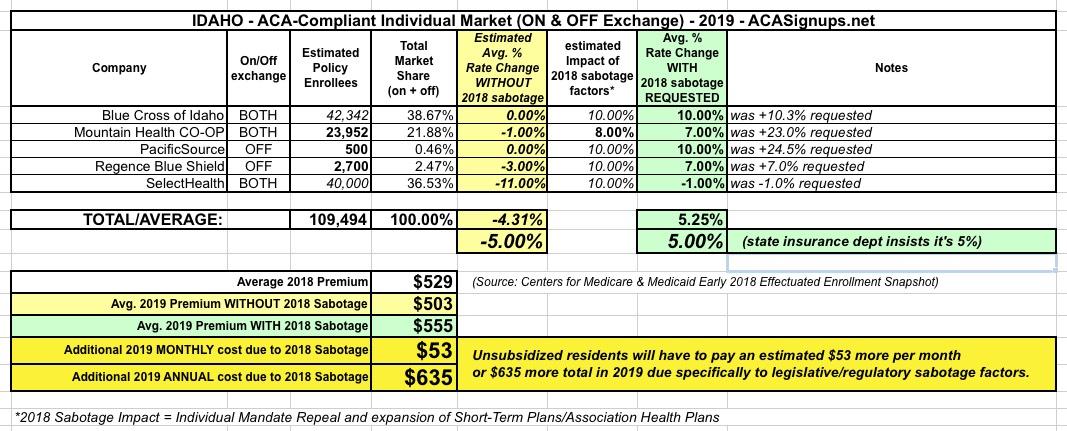Idaho: APPROVED 2019 #ACA rate changes: 5% increase; likely would have DROPPED 5% w/out #ACASabotage
Last month, the Idaho Insurance Department posted the preliminary 2019 ACA individual market rate change requests. They were pretty straightforward, averaging around an 8% increase across the market.
A few days ago, the Idaho DOI issued their final/approved rate changes, knocking a few points off the hikes and bringing the weighted average increase down to 5%:
The Department of Insurance received preliminary 2019 health plan information from insurance carriers on June 1 and began reviewing the proposed plan documents and rates for compliance with Idaho and federal regulations. The Department of Insurance does not have the authority to set or establish insurance rates, but it does have the authority to deem rate increases submitted by insurance companies as reasonable or unreasonable. After the review and negotiation process, the carriers submit their final rate 2019 increase information. The public is invited to provide comments on the rate changes. Please send any comments to Idaho Department of Insurance.
A key driver of increases is generally the level of health claims paid compared to the premium collected. The table below shows the level of claims paid and premium collected by each insurance company for ACA-compliant health benefit plans during 2017. In addition to claims paid, the premium needs to cover the company’s administrative costs, insurance fees, and taxes. Those costs generally consume around 20 of the premium. Larger rate increases may be needed when the prior year’s premium is not sufficient to pay for health claims and administrative costs and fees. With its rate increase submission, each insurance company submits a consumer-oriented explanation of the increase, which is available by clicking on the name of the insurance company in the table below.
Each health benefit plan has an associated “metal level” of Bronze, Silver, Gold, or Catastrophic and offers, at a minimum, Idaho's Essential Health Benefits package. The metal level is assigned based on the policyholder's "cost-sharing," which includes any deductibles, coinsurances, copays, and out-of-pocket maximums. A Silver plan usually will have lower cost-sharing than a Bronze plan, and a Gold plan will usually have lower cost-sharing than a Silver plan. However a Gold plan usually has a higher monthly premium than a Silver plan, and a Silver plan usually has a higher monthly premium than a Bronze plan. Policyholders are able to choose which metal level and which plan within that metal level best works for them.
Pretty straightforward. Here's what it looks like on my own spreadsheet. I've shaved a couple of points off of my estimated #ACASabotage impact as well, and now estimate that the combined effect of the individual mandate being repealed + the expansion of #ShortAssPlans in Idaho is likely around 10% even as opposed to the 12% or so I had previously estimated.
Unsubsidized enrollees pay around $529/month in Idaho at the moment, so that's around a $53/month difference, or around $635 more for 2019 per enrollee.





